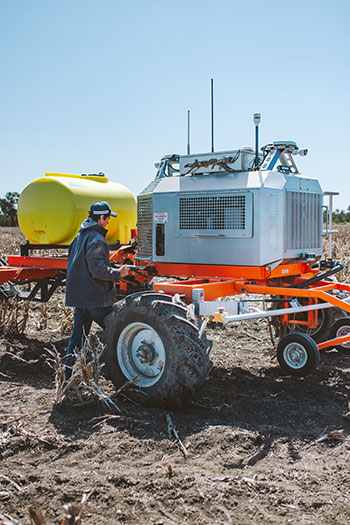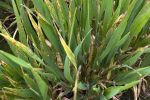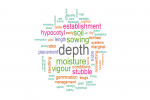Impressed by a neighbour’s machine, New South Wales growers Charlie and Elsie Buchanan decided that an autonomous SwarmBot would benefit weed control in their cropping operation
Once paddocks have been properly mapped and tested, autonomous weed spraying units can be deployed ‘to do their thing’. That was one of the attractions that persuaded Charlie Buchanan to buy a SwarmBot from SwarmFarm Robotics in 2023. Another was cost.
He had intended to trade in a Goldacres dual-line boom fitted with WeedSeeker® sensors for a new 36-metre Hayes dual-line system with WEED-IT cameras, but faced a 12-month wait for delivery.
In the interim, Charlie was so impressed by a neighbour’s SwarmBot that he changed tack completely, switching to an 18m Hayes boom spray with new generation WEED-IT and a Boris 76 SwarmBot, all for a similar price to what he would have paid for the 36m boom alone.
The new kit arrived at the 13,350-hectare family farm, ‘Bungle Gully’, near Come By Chance, New South Wales, in September 2023. Charlie says it has already proven its worth and he expects it to pay for itself in three years.
Charlie, a third-generation grain producer, and his wife, Elsie, recently took over the farm from his parents, Bill and Fiona.
They crop about 60 per cent of Bungle Gully. The rest is mostly native pastures grazed by 500 black-face Dorper ewes and up to 2000 trade steers, which are bought at 240 to 280kg, finished on fodder crops and sold to feedlots at 420 to 440kg.
 Charlie Buchanan with his SwarmFarm SwarmBot in a sorghum stubble paddock. Photo: Kirsty Fisher
Charlie Buchanan with his SwarmFarm SwarmBot in a sorghum stubble paddock. Photo: Kirsty Fisher
Winter crops include fodder barley varieties, such as Moby, and wheat, chickpeas, canola and faba beans for grain. Summer crops are forage sorghum, grain sorghum and dryland cotton.
Average annual rainfall is about 500 millimetres but highly variable, ranging from as little as 195mm during the 1902 Federation drought up to 1080mm in 2022.
This variability, and recent periods when crops were severely affected by drought followed by flooding, makes calculating average yields difficult. However, ignoring those seasons when crops were wiped out, Charlie says their wheat crops have averaged about 4t/ha, canola 3t/ha, chickpeas 2.5t/ha and cotton 2.5 bales/ha in the past five years.
With frontage to Baradine Creek (known locally as Bungle Gully Creek) and the Namoi River, the Buchanans have a small irrigation licence and lease their water to other growers in the area.
The landscape is flat, making it perfect for an autonomous vehicle such as the SwarmBot. Charlie says the SwarmBot has made a big difference already, identifying thumbnail-sized weeds in thick stubble, using less chemical because of fewer misfires, and saving on labour costs by being able to operate 24/7 at a maximum speed of 10km/h without needing a human worker to drive it.
“You could work it day and night, if need be,” he says. “It’s got its own onboard weather station, so you set the spraying parameters, in accordance with the label requirements. It works any day of the week, weekends, Christmas Day; as long as it’s got fuel and chemical, it will go. It’s definitely the way forward.”
GroundCoverTM story: Automation investment paying off

























































